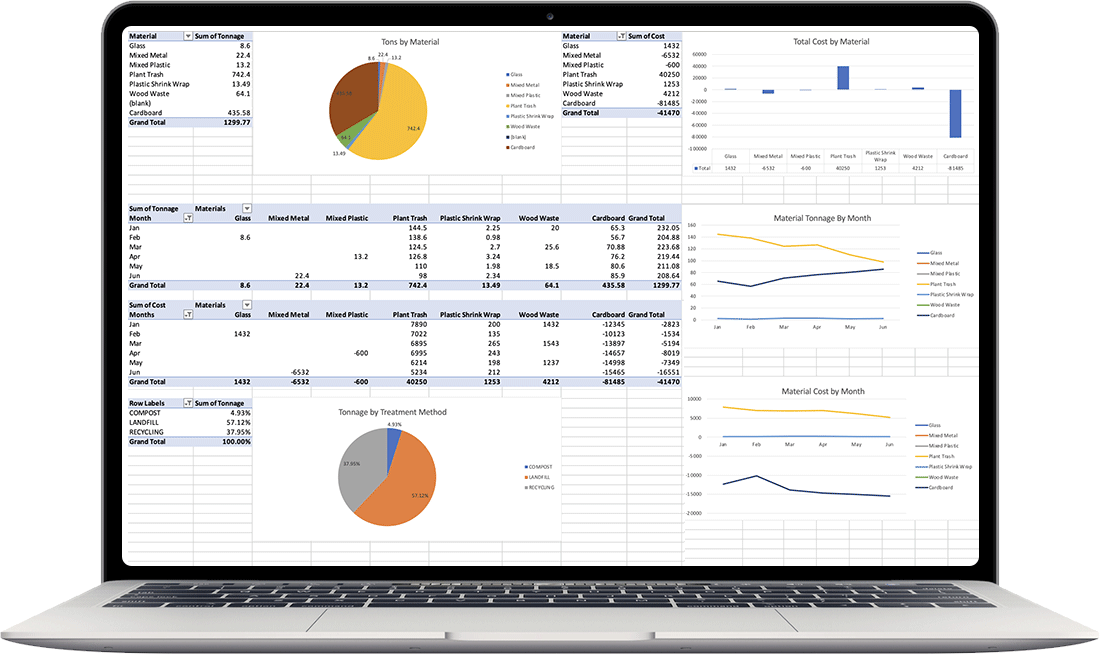“SaaS” is short for “Software as a Service,” which describes a popular approach for building, deploying, and enabling user access to software. With a “SaaS” tool, customers can sign up and use the software without worrying about infrastructure, backups, servers, security patches, and other back-end considerations. That means users spend less time on IT-related tasks and more time extracting value from the software.
SaaS has revolutionized the software industry over the past few decades, leading to a variety of software options for businesses across almost every industry. The waste industry is no exception.
Let’s take a look at the potential benefits of using waste management SaaS along with a few steps for implementation.
Why the “SaaS” Model Makes Sense for Waste Brokers
Modern organizations are increasingly motivated (and, in some cases, required) to track, manage, and report on sustainability goals. Sustainability reporting represents a golden opportunity for waste brokers to deliver even more value to their clients. Software like RecycleERP delivers the sustainability insights that clients need while streamlining time-consuming tasks for the waste broker, such as ordering, billing and invoicing, pricing management, and profit tracking. And, since RecycleERP is provided as a SaaS, the waste broker enjoys numerous other benefits compared to traditional software.
24/7 availability: Many companies maintain around-the-clock operations, which means they may need to view sustainability data and request service during off-hours. If you’re hosting your own waste software, an unexpected electricity outage at 2 am could lead to missed orders, unhappy customers, and stressed out team members. Partnering with a reliable SaaS vendor reduces the chance for downtime and makes 24/7 availability more feasible.
Lower upfront investment: Procuring hardware, software, and technical expertise to run your own customer-facing web application represents a sizable upfront investment. Opting for a waste management SaaS eliminates much or all of that investment in exchange for a recurring subscription fee.
Easier to maintain: With most SaaS tools, updates and security patches are rolled out by the vendor with no manual effort by the customer. Backups are maintained continuously too, thereby reducing risk and increasing confidence in the platform.
Flexibility and accessibility: Some SaaS vendors price their software on a per-user basis, while others (like RecycleERP) charge a flat monthly fee that includes a set number of users. For example, our Standard plan includes up to 100 users. And, since users can securely log in from any web-enabled device, they’ll be able to work at the office or at home.
Ease of integration: SaaS tools are already in the cloud, which makes it even easier to connect to other cloud tools like your accounting system.
5 Steps for Implementing Waste Management SaaS
If you’re thinking that waste management SaaS might be right for your business, here are some steps to begin working through:
1. Make a List of Current & Future Needs
Start by gaining an objective view of your existing processes and technology. Do you already have software in place that supports your daily operations? What do you like about the software? What gaps exist and how have they negatively impacted customer relationships and employee efficiency? How will these gaps expand or contract as you gain additional customers, expand your services, hire more people, and increase revenue?
2. Compare Your Needs vs. Vendor Features
Gaining a firm understanding of current and future needs makes it easier to objectively evaluate your options. Websites such as G2.com and Capterra.com offer detailed lists and summaries about waste management vendors. For example, here’s the RecycleERP page on G2.com. Spend time comparing product features and begin formulating a shortlist of vendors that align with your needs.
3. Participate in Demos & Finalize Your Decision
Be an active participant during your demos with SaaS vendors. Do your homework in advance and come prepared with specific questions. Don’t be shy to ask for follow-up demos if necessary. Depending on your company’s structure, it may be wise to invite stakeholders from IT, sales, accounting, finance, and/or operations to join the demos. Doing so could accelerate the decision-making process and prevent future interoffice drama.
4. Partner with Your SaaS Vendor for a Smooth Implementation
Although SaaS eliminates many of the IT-related aspects of software implementation, there are still several factors to consider for a smooth implementation. For example, if you’re currently using another software, you’ll need to figure out how to migrate data. You’ll also need to onboard users to the new system and ensure they have the right permissions and training.
5. Continuously Work to Maximize Adoption
Don’t get frustrated if implementing a SaaS product doesn’t instantly cure all of your operational challenges. Some users may find it difficult to give up their previous ways of doing things. Others may feel threatened that parts of their jobs are being automated by software. These are all valid concerns and should not be taken lightly. Strive to educate your staff and help them reorient their time to higher-impact responsibilities. Maximizing adoption can be a long-term proposition, but it’s usually worth it.
Learn More about RecycleERP
RecycleERP is a waste management SaaS that’s built for waste brokers and vendors. Affordable monthly plans include features that streamline service requests, billing, reporting, sales management, customer relationships, and much more.
Request a demo of RecycleERP.

